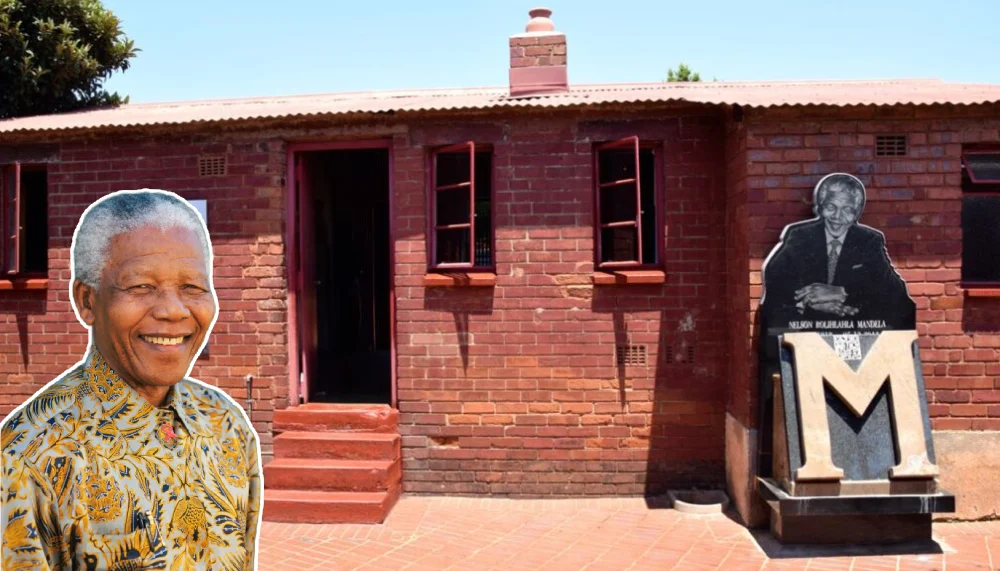Mandela House is the former residence of Nelson Mandela, located at 8115 Vilakazi Street, Orlando West, Soweto. Now a museum, this modest four-room brick house preserves the memory of South Africa’s most iconic leader and offers visitors an authentic glimpse into his personal life and struggle journey.
You stand before a small brick house that changed the world. Nelson Mandela called this place “the centre point of my world, the place marked with an X in my mental geography.” Today, thousands of visitors from around the globe make the pilgrimage to 8115 Vilakazi Street in Soweto.
This isn’t just any museum. It’s the preserved home where the future president lived with his wives and children before his 27-year imprisonment. Every room tells a story. Every artifact holds significance. You’ll discover why this humble dwelling became the symbol of resistance against apartheid.
What Makes Mandela House Special
Built in 1945, the house became Nelson Mandela’s home in 1946 when he moved in with his first wife, Evelyn Ntoko Mase. The modest structure witnessed some of the most pivotal moments in South African history.
Mandela lived here with both his first wife, Evelyn, and later with his second wif,e Winnie. The four-room house served as more than a residence. It became a meeting place for anti-apartheid activists and a symbol of hope for millions of South Africans.
The building itself tells a powerful story. Despite being firebombed and attacked multiple times during the apartheid era, the structure survived. Today, bullet holes and scorch marks remain visible, serving as permanent reminders of the violence and resistance that shaped modern South Africa.
Inside the Mandela House Museum
The museum houses art, memorabilia, honorary doctorates awarded to the family, and photographs dating back to the 1950s. You’ll walk through the same rooms where Mandela planned resistance activities and spent precious moments with his family.
The living room displays original furniture and personal items. Family photographs line the walls, showing intimate moments from the Mandela family’s daily life. The kitchen remains largely unchanged, with period-appropriate appliances and utensils.
One of the most moving exhibits is Mandela’s study. His desk, books, and legal documents provide insight into his work as a lawyer and activist. The bedroom contains clothing, awards, and personal effects that humanize this global icon.
The museum also features rotating exhibits about the broader anti-apartheid movement. These displays connect Mandela’s personal story to the larger struggle for freedom in South Africa.
Visiting Hours and Ticket Information
The museum opens daily from 09:00 to 17:00, closing only on Good Friday and Christmas Day. Plan your visit during weekday mornings for smaller crowds and a more intimate experience.
Entry fees vary by nationality: foreign visitors pay ZAR 60 ($4), African Union residents pay ZAR 40 ($3), and children over 6 years pay ZAR 20 ($1). Children under 6 enter for ZAR 5. Students and pensioners receive discounted rates.
Soweto residents get half-price admission with valid proof of residence. Groups are limited to 20 people maximum, and the house is wheelchair accessible.
Purchase tickets at the entrance or book through tour operators. During peak tourist season (December-February), arrive early to avoid long queues.
Getting to Mandela House
The museum sits in Orlando West, one of Soweto’s most historic neighborhoods. The location is not within walking distance of public transportation, so plan your transport carefully.
Most visitors arrive by car or organized tour bus. If driving, use GPS coordinates for 8115 Vilakazi Street, Orlando West, Soweto. Parking is available on the street, but spaces fill quickly on weekends.
Tour companies offer half-day and full-day Soweto tours that include Mandela House. These typically combine visits to other nearby attractions like Regina Mundi Church and Hector Pieterson Memorial.
Uber and Bolt operate in the area, providing safe and convenient transport options. However, confirm your driver’s familiarity with Soweto before booking.
What to Expect During Your Visit
Your museum experience lasts approximately 45-60 minutes. Audio guides are available in multiple languages, providing detailed context about each room and artifact.
Photography is permitted in most areas, but flash photography is prohibited to protect sensitive documents and photographs. Respectful behavior is expected, given the sacred nature of this historical site.
The museum staff includes knowledgeable guides who share personal stories and historical context. Many grew up in Soweto and provide unique insights into community life during apartheid.
Security measures are in place, including bag checks at entry. Leave large bags and unnecessary items in your vehicle or hotel room.
Exploring Vilakazi Street
Vilakazi Street holds special significance as the only street in the world where two Nobel Peace Prize winners lived. Besides Mandela House, Archbishop Desmond Tutu’s former residence is just blocks away.
The street buzzes with activity. Sakhumzi’s restaurant sits nearby, offering traditional South African cuisine. Street vendors sell crafts, artwork, and souvenirs related to Mandela and South African history.
Local musicians and dancers often perform on the street, creating a vibrant cultural atmosphere. These informal performances add authentic energy to your historical journey.
Several other attractions within walking distance include the Soweto Theatre and various community art projects that celebrate local culture and history.
Tips for a Meaningful Visit
Arrive with basic knowledge of South African history and Mandela’s life story. This background context will make your museum experience more meaningful and emotionally impactful.
Allow extra time to interact with local guides and community members. Their personal stories and perspectives provide invaluable context that you won’t find in guidebooks.
Consider visiting during Heritage Month (September) when special events and exhibitions often take place. The museum frequently hosts cultural programs and educational activities.
Combine your visit with other Soweto attractions to understand the broader community context. The Hector Pieterson Memorial and Museum, located nearby, provides essential background about the 1976 student uprising.
Dress respectfully and comfortably. You’ll be walking through small rooms and standing for extended periods during guided explanations.
Beyond the Museum Walls
The museum’s mission focuses on providing “an environment of mutual respect, dignity, and reconciliation” where visitors can experience Mandela’s story and life philosophy. This commitment extends beyond the physical exhibits.
Educational programs serve local schools and international student groups. These initiatives ensure Mandela’s message reaches new generations and continues inspiring social change.
The museum also partners with other Mandela-related sites across South Africa, including the Nelson Mandela Museum in his birthplace of Mthatha, Eastern Cape.
Community involvement remains central to the museum’s operations. Local residents serve as guides, vendors, and cultural performers, ensuring tourism benefits the broader Soweto community.
Planning Your Soweto Adventure
Most visitors spend 3-4 hours exploring Orlando West and the surrounding areas. Start early in the morning to maximize your time and enjoy cooler temperatures.
Book accommodations in nearby Johannesburg rather than staying in Soweto itself. The city center offers more hotel options and easier access to other attractions.
Pack bottled water and snacks, especially during summer months when temperatures can exceed 30°C (86°F). Limited food options exist immediately around the museum.
Currency exchange is available in central Johannesburg, but ATMs in Soweto may have limited cash availability. Bring sufficient rand for entry fees, tips, and purchases.
FAQs
How long should I spend at Mandela House?
Plan 45-60 minutes for the museum tour, plus additional time for exploring Vilakazi Street and nearby attractions.
Is it safe to visit Soweto independently?
While many visitors explore independently, joining organized tours provides added security and cultural context, especially for first-time visitors.
Can I take photographs inside the museum?
Yes, photography is permitted in most areas. Flash photography is prohibited to preserve sensitive documents and artifacts.
What other attractions are nearby?
Regina Mundi Church, Hector Pieterson Memorial, Archbishop Tutu’s former home, and various community art projects are all within walking distance.
Do I need to book tickets in advance?
Booking isn’t required, but tour groups should call ahead. Individual visitors can purchase tickets at the entrance.
Your Journey to Understanding
Visiting Mandela House connects you directly to one of history’s most important stories of resilience and transformation. This small brick house represents hope, sacrifice, and the power of individual courage to change the world.
The museum preserves not just artifacts, but the spirit of a man who chose forgiveness over revenge and unity over division. Your visit supports ongoing educational programs that keep these vital lessons alive for future generations.
Ready to experience this powerful piece of history? Plan your visit to Mandela House and discover why this modest Soweto home continues inspiring millions worldwide. Book your Soweto tour today and step into the footsteps of greatness.




No Comment! Be the first one.